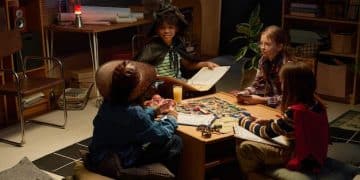The Making of a Cable Hit: Unveiling Secrets of Original Cable Series

The Making of a Cable Hit involves a complex interplay of creative vision, strategic planning, and dedicated execution, often revealing surprising behind-the-scenes stories that contribute to the success of popular original series on cable networks.
Discover the intricate process of the making of a cable hit, exploring the hidden strategies and unexpected challenges that contribute to the success of popular original series, offering a unique behind-the-scenes look at what makes these shows resonate with audiences.
The Genesis of a Cable Series: From Pitch to Pilot
The journey of a cable hit begins long before it graces our screens. It starts with an idea, a spark of creativity that morphs into a pitch – a concise and compelling presentation designed to entice network executives.
From crafting the initial pitch to navigating the complexities of pilot season, the path to creating a successful cable series is fraught with challenges and demanding decisions.
Crafting the Perfect Pitch
The initial pitch is crucial. It’s the first impression, the make-or-break moment where creators must captivate the attention of network executives. A strong pitch will convey not only the concept but also the potential for longevity and audience engagement.
Often, pitches involve a detailed outline of the first season, character sketches, and even visual aids to bring the concept to life and showcase the series’ unique selling points.
Navigating Pilot Season
If a pitch is successful, the next step is often the creation of a pilot episode. Pilot season is a critical period where networks assess numerous potential series, making it a highly competitive environment.
Producing a pilot involves assembling a talented cast and crew, managing budgets, and ensuring the episode captures the essence of the proposed series while leaving viewers wanting more.
- Securing funding for the pilot episode is a major hurdle.
- Casting decisions can significantly impact the series’ appeal.
- Post-production plays a vital role in shaping the final product.
- Gaining network approval is essential to moving forward.
Ultimately, the careful navigation of these challenges shapes the series that viewers come to adore, setting the stage for a cable hit.

The Writing Process: Building Characters and Storylines that Resonate
The writing process is the heart of any successful cable series. It is here that characters are brought to life, storylines are developed, and the overall tone of the show is defined.
From the initial concept to the final script, the writers’ room is a dynamic space where creativity and collaboration intersect to shape the narrative.
The Collaborative Writers’ Room
The writers’ room is often a collaborative environment where a team of writers brainstorms ideas, develops storylines, and crafts the dialogue that brings the series to life.
This collaborative process allows for diverse perspectives and ensures that the writing remains fresh, engaging and often incorporates feedback from showrunners and executive producers.
Character Development and Arcs
One of the most critical aspects of the writing process is the development of compelling characters. Characters need to be believable, relatable, and have their own distinct motivations and backstories.
Creating well-defined character arcs – the journey a character takes throughout the series – is vital in keeping viewers invested and engaged. These arcs involve growth, challenges, and transformations that make the characters feel real and dynamic.
- Conducting thorough character research.
- Creating detailed backstories and motivations.
- Mapping long-term character development.
- Incorporating audience feedback to refine characters.
In conclusion, the writing process is a blend of creativity, collaboration, and meticulous planning, and it plays a vital role in the making of a cable hit.
Casting the Perfect Ensemble: Assembling a Talented Cast
Casting is a crucial step in the making of a cable hit. The actors who embody the characters bring the written word to life, and their performances can significantly impact the show’s success.
The casting process involves finding actors who not only fit the physical descriptions but also possess the talent and charisma to embody the characters fully.
The Audition Process
The audition process is rigorous and often involves multiple rounds of auditions, chemistry reads, and screen tests. Casting directors and showrunners work closely together to identify the actors who best fit the roles and can complement the existing cast.
Casting directors often look for actors who bring their own unique interpretations to the characters, adding layers of depth and complexity.
Chemistry and On-screen Presence
Chemistry between actors is vital, especially when portraying relationships or ensembles. The ability to create authentic connections on screen can elevate the storytelling and make the characters more believable.
On-screen presence – an actor’s ability to command attention and captivate viewers – is another critical factor. This intangible quality can be the difference between a good performance and a standout one.
- Extensive audition rounds and callbacks
- Chemistry reads to ensure cast compatibility
- Screen tests for visual assessment
- Negotiating contracts and availability
Finding the right actors who embody their characters effectively and create genuine on-screen connections significantly enhances the show’s overall impact and contributes to the making of a cable hit.
Directing and Producing: Setting the Visual and Creative Tone
Directing and producing play pivotal roles in shaping the visual and creative tone of a cable series. Directors are responsible for translating the script into a visual medium, while producers oversee the entire production process, ensuring that the show stays on budget and on schedule.
Effective direction and production are essential for creating a cohesive and compelling viewing experience that resonates with audiences.
The Director’s Vision
The director is the creative visionary who brings the script to life. They work closely with the writers, actors, and cinematographers to establish the visual style, pacing, and overall tone of the show.
Directors make critical decisions about camera angles, shot composition, and actor performances, all of which contribute to the storytelling and emotional impact of each scene.
The Producer’s Role
Producers are the logistical backbone of the production, overseeing every aspect from budgeting and scheduling to hiring crew members and managing post-production.
They ensure that the production runs smoothly, navigating challenges and making critical decisions to keep the show on track and within budget.

- Coordinating various departments for seamless production.
- Managing budgets and securing financing.
- Ensuring adherence to the creative vision.
- Addressing logistical and technical challenges.
Their combined efforts ensure that each episode aligns with the overall vision of the series and delivers a high-quality viewing experience.
Marketing and Promotion: Building Buzz and Reaching Audiences
Marketing and promotion are vital for building buzz around a cable series and reaching audiences. Effective marketing campaigns can create anticipation, generate interest, and drive viewership.
From targeted advertising to social media engagement, a comprehensive marketing strategy can elevate a cable series from obscurity to widespread recognition.
Targeted Advertising Campaigns
Targeted advertising campaigns involve identifying the show’s target audience and crafting messages that resonate with them. These campaigns may include television commercials, online ads, print ads, and billboards.
Effective advertising highlights the unique selling points of the series, whether it’s the compelling characters, gripping storylines, or visually stunning cinematography.
Social Media Engagement
Social media platforms play a crucial role in promoting cable series. Engaging with fans on social media can create a sense of community and generate word-of-mouth marketing.
Social media campaigns often include behind-the-scenes content, Q&A sessions with the cast and crew, and interactive contests and giveaways to keep fans engaged and excited about the show.
- Leveraging social media platforms for engagement.
- Creating viral marketing campaigns.
- Utilizing data analytics to target viewers.
- Collaborating with influencers and media outlets.
The Impact of Streaming Services on Cable Originals
The increasing popularity of streaming services has significantly influenced the cable industry, leading to both challenges and opportunities for cable originals. Streaming platforms have changed how content is consumed, prompting cable networks to adapt their strategies.
Cable networks must now compete with the vast libraries of streaming services, offering compelling original content to retain subscribers and attract new viewers.
The Rise of Binge-Watching
Streaming services have popularized binge-watching, where viewers consume multiple episodes of a series in a single sitting. This trend has changed the way stories are told, with cable originals often adopting serialized narratives that encourage binge-watching.
Cable networks have responded by releasing entire seasons of their original series on-demand, catering to viewers’ desire to binge-watch.
Content Diversification and Niche Programming
In response to the competition from streaming services, cable networks have diversified their content offerings, focusing on niche programming that appeals to specific audiences.
By targeting specific demographics and interests, cable networks can create loyal fan bases and differentiate themselves from the broader offerings of streaming platforms.
- Increasing investment in original content.
- Embracing digital distribution strategies.
- Analyzing viewing data to inform programming decisions.
- Creating interactive and immersive viewer experiences.
Cable networks are adapting their strategies to thrive in the evolving media landscape.
| Key Point | Brief Description |
|---|---|
| 💡 Pitching the Series | A compelling pitch is crucial for grabbing the network’s attention and securing initial funding and approval. |
| ✍️ Writing Process | Collaborative writing, character development, and strong storylines are essential for audience engagement. |
| 🎭 Casting | Finding actors who fit the characters and have good on-screen chemistry is essential. |
| 📣 Marketing | Effective marketing and social media engagement are critical for attracting viewers and keeping them hooked. |
Frequently Asked Questions
▼
A strong pitch should include a clear concept, well-developed characters, a compelling storyline, and a demonstration of the series’ potential for longevity. Highlighting the unique selling points is also crucial.
▼
The writing process shapes everything from character arcs to dialogue. A collaborative, creative writer’s room that focuses on compelling storylines is essential. It also needs to maintain audience engagement.
▼
The cast brings the written word to life. Finding actors who embody their characters and have strong on-screen chemistry can significantly impact the show’s success. This also enhances storytelling.
▼
Streaming has intensified competition, prompting cable networks to invest more in original content, embrace digital distribution, and focus on niche programming to retain viewers. Binge-watching is also now a key component to series releases.
▼
Marketing builds buzz and reaches audiences. Effective ad campaigns, social media engagement, and strategic partnerships can create anticipation. These elements help drive viewership for the series.
Conclusion
Understanding the nuanced layers of cable show production, from creative inception to strategic marketing, reveals the dedicated collaboration required for a series to resonate with audiences and achieve sustainable success. By recognizing the crucial behind-the-scenes elements, one can appreciate the complexity involved in the making of a cable hit.





